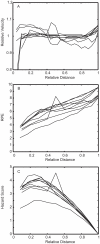Regulation of pacing strategy during athletic competition
- PMID: 21283744
- PMCID: PMC3024328
- DOI: 10.1371/journal.pone.0015863
Regulation of pacing strategy during athletic competition
Abstract
Background: Athletic competition has been a source of interest to the scientific community for many years, as a surrogate of the limits of human ambulatory ability. One of the remarkable things about athletic competition is the observation that some athletes suddenly reduce their pace in the mid-portion of the race and drop back from their competitors. Alternatively, other athletes will perform great accelerations in mid-race (surges) or during the closing stages of the race (the endspurt). This observation fits well with recent evidence that muscular power output is regulated in an anticipatory way, designed to prevent unreasonably large homeostatic disturbances.
Principal findings: Here we demonstrate that a simple index, the product of the momentary Rating of Perceived Exertion (RPE) and the fraction of race distance remaining, the Hazard Score, defines the likelihood that athletes will change their velocity during simulated competitions; and may effectively represent the language used to allow anticipatory regulation of muscle power output.
Conclusions: These data support the concept that the muscular power output during high intensity exercise performance is actively regulated in an anticipatory manner that accounts for both the momentary sensations the athlete is experiencing as well as the relative amount of a competition to be completed.
Conflict of interest statement
Figures





References
-
- Foster C, Schrager M, Snyder AC, Thompson NN. Pacing strategy and athletic performance. Sports Med. 1994;17:77–85. - PubMed
-
- Abbiss CR, Laursen PB. Describing and understanding pacing strategies during athletic competition. Sports Med. 2008;38:239–252. - PubMed
-
- Tucker R, Noakes TD. The physiological regulation of pacing strategy during exercise: a critical review. Br J Sports Med. 2009;43:e1. DOI: 10.1136/bjsm.2009.057562. - DOI - PubMed
MeSH terms
LinkOut - more resources
Full Text Sources

